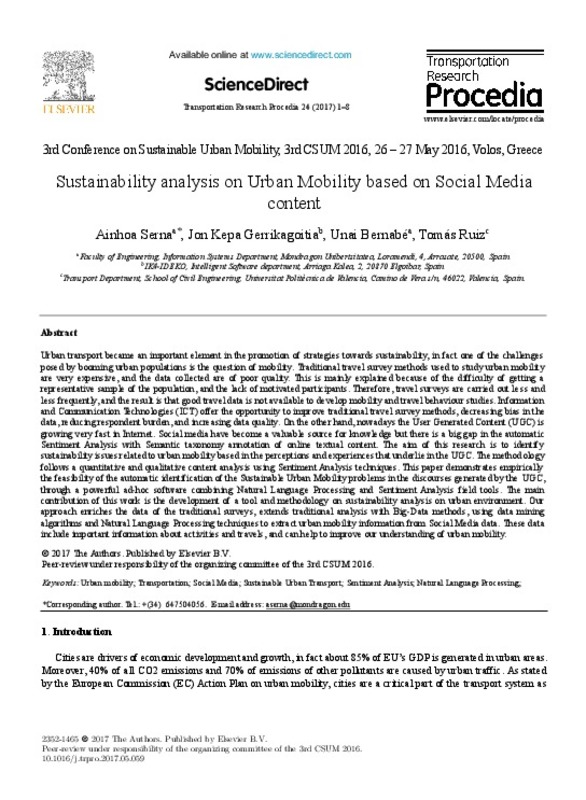|
Resumen:
|
[EN] Urban transport became an important element in the promotion of strategies towards sustainability, in fact one of the challenges posed by booming urban populations is the question of mobility. Traditional travel survey ...[+]
[EN] Urban transport became an important element in the promotion of strategies towards sustainability, in fact one of the challenges posed by booming urban populations is the question of mobility. Traditional travel survey methods used to study urban mobility are very expensive, and the data collected are of poor quality. This is mainly explained because of the difficulty of getting a representative sample of the population, and the lack of motivated participants. Therefore, travel surveys are carried out less and less frequently, and the result is that good travel data is not available to develop mobility and travel behaviour studies. Information and Communication Technologies (ICT) offer the opportunity to improve traditional travel survey methods, decreasing bias in the data, reducing respondent burden, and increasing data quality. On the other hand, nowadays the User Generated Content (UGC) is growing very fast in Internet. Social media have become a valuable source for knowledge but there is a big gap in the automatic Sentiment Analysis with Semantic taxonomy annotation of online textual content. The aim of this research is to identify sustainability issues related to urban mobility based in the perceptions and experiences that underlie in the UGC. The methodology follows a quantitative and qualitative content analysis using Sentiment Analysis techniques. This paper demonstrates empirically the feasibility of the automatic identification of the Sustainable Urban Mobility problems in the discourses generated by the UGC, through a powerful ad-hoc software combining Natural Language Processing and Sentiment Analysis field tools. The main contribution of this work is the development of a tool and methodology on sustainability analysis on urban environment. Our approach enriches the data of the traditional surveys, extends traditional analysis with Big-Data methods, using data mining algorithms and Natural Language Processing techniques to extract urban mobility information from Social Media data. These data include important information about activities and travels, and can help to improve our understanding of urban mobility. (C) 2017 The Authors. Published by Elsevier B.V.
[-]
|
|
Agradecimientos:
|
This research has been supported by:
Cost Action TU1305 Social Networks and Travel Behaviour. COST is supported by the EU Framework Programme Horizon 2020.
Spain R+D programs: Ministry of Economy and competitiveness. ...[+]
This research has been supported by:
Cost Action TU1305 Social Networks and Travel Behaviour. COST is supported by the EU Framework Programme Horizon 2020.
Spain R+D programs: Ministry of Economy and competitiveness. State Program of Research, Development and Innovation Facing the Challenges of the Company under the State Plan of Scientific and Technical Research and Innovation. Spanish government MINERVA-Innovative Travel Data Collection Methods for Transport Planning coordinated by Universitat Politecnica de Valencia and Mondragon Unibertsitatea.
Editorial
[-]
|









